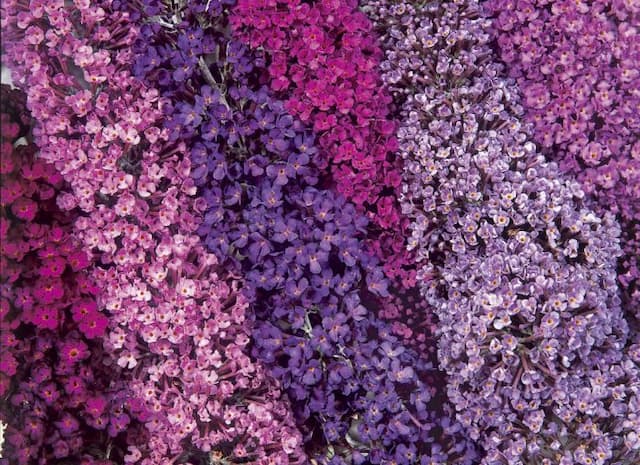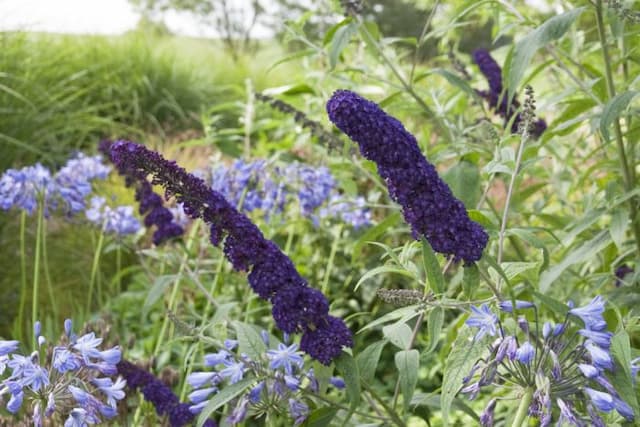Woolly Mullein Verbascum phlomoides

ABOUT
Verbascum phlomoides, commonly known as orange mullein, is a biennial plant distinguished by a rosette of leaves and a flowering spike. The leaves are hairy, with a woolly texture, and are grayish-green in color. They form a low-lying basal rosette in the first year, and in the following year, they climb up the stem that supports the flowers. The stem is also covered in starry hairs, imparting a silvery appearance. The flowers are the most striking feature of the plant. They blossom in dense clusters on the upper part of the stem, typically in the second year. Each individual flower is characterized by five rounded petals, which are usually bright yellow, giving the plant an eye-catching appeal. The flower's center often has a bit of orange. It's surrounded by a set of stamens that are covered in purple or orange hairs, which adds contrast and flair to the flower's display. This plant is often found in open, sunny habitats and produces a tall flower spike, which carries the showy bloom. The flowering period for orange mullein extends through the summer months, during which time it attracts a variety of pollinators, including bees and butterflies. The overall aesthetic of orange mullein is one of rustic charm, with its fuzzy leaves and bright, nectar-rich flowers providing a vibrant touch to the landscapes where it grows.
About this plant
 Names
NamesFamily
Scrophulariaceae
Synonyms
Orange Mullein, Wooly Mullein, Phlomis-leaved Mullein
Common names
Verbascum ovatum, Verbascum phlomoides subsp. ovatum.
 Toxicity
ToxicityTo humans
The plant Verbascum phlomoides, commonly known as orange mullein, is not typically listed as poisonous to humans. However, like many plants, it may cause irritation or an allergic reaction in some people if handled or ingested. It is always advisable to exercise caution and avoid ingesting plants unless they are known to be safe and are prepared correctly. If an individual does consume orange mullein and experiences adverse effects such as nausea, vomiting, diarrhea, or allergic reactions, they should seek medical attention.
To pets
Orange mullein (Verbascum phlomoides) is not commonly known to be toxic to pets. While it is generally not associated with severe toxicity, ingestion of plant material by pets can sometimes lead to gastrointestinal discomfort or reactions in sensitive animals, including vomiting or diarrhea. As a precaution, it is always recommended to prevent pets from consuming plants that are not verified as safe for their consumption. If a pet exhibits unusual symptoms after ingesting any part of the orange mullein plant, it is advisable to consult a veterinarian.
 Characteristics
CharacteristicsLife cycle
Biennials
Foliage type
Deciduous
Color of leaves
Green
Flower color
Yellow
Height
5 feet [1.52 meters]
Spread
2 feet [0.61 meters]
Plant type
Herb
Hardiness zones
5
Native area
Europe
Benefits
 General Benefits
General Benefits- Attracts Pollinators: Verbascum phlomoides is known to attract bees and butterflies, which are essential for pollination in the garden.
- Drought Tolerance: Once established, it is relatively drought-resistant, making it suitable for xeriscaping and low-water gardens.
- Decorative Flowers: It produces tall spikes of yellow flowers, which can add aesthetic value and height variation to garden designs.
- Low Maintenance: This plant does not require frequent watering or fertilizing, making it a convenient choice for gardeners with limited time.
- Fast Growth: Verbascum phlomoides is capable of quick growth under the right conditions, allowing for rapid filling of garden spaces.
- Soil Adaptability: It can thrive in a wide range of soil types, from sandy to loamy, as long as the soil is well-draining.
- Erosion Control: With its deep root system, the plant can help stabilize soil and prevent erosion on slopes.
- Ecological Support: The seeds produced by Verbascum phlomoides can provide food for birds and other wildlife in the ecosystem.
 Medical Properties
Medical Properties- Anti-inflammatory: Verbascum phlomoides is traditionally used for its anti-inflammatory properties to help reduce swelling and inflammation.
- Expectorant: It has been utilized for its expectorant effects, helping to loosen and expel phlegm from the respiratory tract.
- Demulcent: The plant provides a soothing effect on mucous membranes, useful for treating irritated throat and cough.
- Astringent: It has astringent properties that can help in tightening tissues and stanching bleeding.
- Diuretic: Verbascum phlomoides is believed to promote the production of urine, aiding in the flushing of the urinary tract.
- Emollient: Its emollient properties are known for softening and soothing the skin when applied topically.
- Antimicrobial: There is evidence to suggest that the plant possesses antimicrobial properties that could help in fighting against certain bacteria and fungi.
- Analgesic: Traditionally, it may have been used for its pain-relieving effects.
 Air-purifying Qualities
Air-purifying QualitiesThis plant is not specifically known for air purifying qualities.
 Other Uses
Other Uses- Natural dye source: The flowers of Mullein (Verbascum phlomoides) can be used to produce a yellow or green dye, depending on the mordant used, for coloring fabrics.
- Fish poison: Historically, some species of Verbascum were used to stupefy fish, making them easier to catch, though this practice is not environmentally friendly and is now illegal in many areas.
- Torch material: The dried stalks of Mullein can be dipped in suet or wax to create torches, a use common in ancient times.
- Natural insecticide: The saponins present in Mullein might deter insects and can be used in the garden as a natural pest control measure.
- Livestock feed: In some areas, Mullein is used as emergency fodder for livestock, although it's not the most nutritious option.
- Furniture polish: The leaves of Mullein can be used to create a natural polish for wooden furniture, imparting a soft sheen and protection.
- Insulation material: The fluffy leaves and fibers of Mullein could be used historically as insulation in clothing or buildings.
- Wick for oil lamps: The fibrous Mullein stems can be used as a natural wick for oil lamps and candles.
- Gardening felt: When left to decompose, the dense foliage can be used as a matting to suppress weeds in gardens.
- Papermaking: The fibrous stalks of Mullein can be incorporated into handmade papers, giving them texture and strength.
Interesting Facts
 Feng Shui
Feng ShuiThe Common Mullein is not used in Feng Shui practice.
 Zodiac Sign Compitability
Zodiac Sign CompitabilityThe Common Mullein is not used in astrology practice.
 Plant Symbolism
Plant Symbolism- Healing: Verbascum phlomoides, commonly known as mullein, has been associated with healing due to its traditional use in herbal medicine, particularly for respiratory ailments.
- Protection: In some folklore, mullein is thought to ward off evil and negative energy, making it a symbol of protection.
- Love: The soft leaves of mullein are sometimes connected with the tenderness of love, perhaps due to their gentle, soothing nature.
- Courage: Due to its ability to thrive in various conditions, mullein can represent courage and the ability to face challenges with resilience.
 Water
WaterOrange mullein, or Verbascum phlomoides, prefers well-drained soil and does not require frequent watering. It's important to water the plant thoroughly, allowing the water to penetrate deep into the root zone. Aim to provide about one gallon of water per week during active growth in spring and summer. During the fall and winter, reduce watering to once every two to three weeks, depending on the weather, as the plant enters a dormant state. Allow the top inch of soil to dry out between waterings to prevent overwatering and potential root rot.
 Light
LightOrange mullein thrives in full sun conditions, where it can receive at least six hours of direct sunlight each day. The best spot for this plant would be an open area without shade from trees or buildings that can provide unfiltered, direct sunlight throughout the day, as this ensures healthy growth and flowering.
 Temperature
TemperatureOrange mullein can withstand temperatures as low as 20°F and can survive in high temperatures typically found during summer months. However, it thrives best in temperatures ranging from 50°F to 80°F. It's important to protect the plant from frost, which could damage its foliage and stems.
 Pruning
PruningPruning Orange mullein is beneficial to encourage a second bloom and to maintain an attractive shape. Deadheading the spent flowers can promote more blooms. Cutting back the taller flower stalks after the first flush of blooms, usually in late summer or early fall, can also help to stimulate new growth. Pruning is best done sparingly, as the plant does not require extensive cutting back.
 Cleaning
CleaningNot needed
 Soil
SoilOrange Mullein requires well-draining, sandy or rocky soil with a pH range of 6.0 to 8.0. A soil mix with one part sand, one part loam, and a hint of compost is ideal as it provides good drainage while also supplying nutrients.
 Repotting
RepottingOrange Mullein typically does not need to be repotted frequently as it is biennial and will complete its life cycle in two years. It is best grown outdoors, so repotting is generally not necessary unless pot-grown.
 Humidity & Misting
Humidity & MistingOrange Mullein prefers a dryer climate and does not require high humidity. It thrives in average atmospheric conditions, and there is no need for increased humidity indoors.
 Suitable locations
Suitable locationsIndoor
Provide full sun through a south-facing window and well-draining soil.
Outdoor
Plant in full sun, well-drained soil, and space 12 inches apart.
Hardiness zone
5-9 USDA
 Life cycle
Life cycleVerbascum phlomoides, commonly known as Orange Mullein or Woolly Mullein, begins its life as a seed that germinates in spring when conditions are moist and warm enough. The seed develops into a rosette of leaves during its first year, focusing on growing a strong root system while staying close to the ground. In its second year, the biennial plant sends up a tall flowering stalk, which can reach up to 2 meters in height, adorned with yellow to orange flowers that are attractive to a variety of pollinators. After the flowering period in summer, seeds are produced and dispersed, completing the reproductive stage. Once seeds have been set, the parent plant typically dies, though sometimes it may survive and flower for another season. The seeds may lie dormant until the next suitable growing season arrives, at which point the cycle begins anew.
 Propogation
PropogationPropogation time
Spring to early summer
Propogation: Common mullein (Verbascum phlomoides) is typically propagated by seed. The best time for sowing the seeds is either directly outdoors in the fall or in the spring after the danger of frost has passed. To propagate common mullein by seed, one must prepare a well-draining soil mix in a flat or container, lightly press the tiny seeds onto the surface of the soil, and barely cover them with soil as they require some light for germination. It is important to keep the soil moist but not waterlogged. Germination usually occurs within 2 to 3 weeks at temperatures around 65 to 85 degrees Fahrenheit (18 to 29 degrees Celsius). Once seedlings have developed sufficient roots and a set of true leaves, they can be transplanted into their final growing location outdoors.


![Butterfly bush [Adonis Blue]](/_next/image?url=https%3A%2F%2Fplants-admin.emdemapps.com%2Fimages%2Fplants%2F%2Fimages%2F604b56e58f983.png&w=640&q=75)


![Butterfly bush [Buzz Ivory]](/_next/image?url=https%3A%2F%2Fplants-admin.emdemapps.com%2Fimages%2Fplants%2F%2Fimages%2F604b57987dfa8.png&w=640&q=75)
![Butterfly bush [Camberwell Beauty]](/_next/image?url=https%3A%2F%2Fplants-admin.emdemapps.com%2Fimages%2Fplants%2F%2Fimages%2F604b5ead04c12.png&w=640&q=75)


